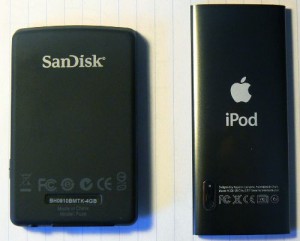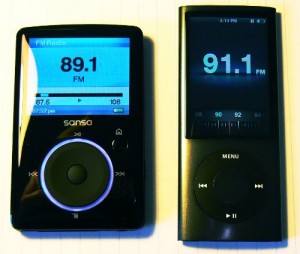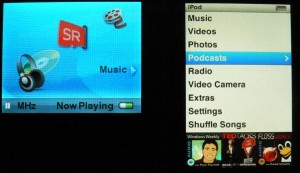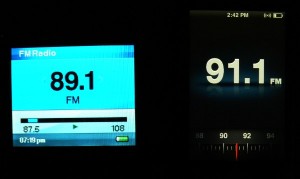This week I took the new 5th generation iPod nano and the Sansa Fuze v2 from Sandisk out for a spin. Despite the large price difference, these two devices are pretty well matched for competition. Trying to decide between the two? Maybe this article can help decide which player is right for you.
The iPod nano is a 16 Gb black model, that came with a dock plate, earbuds, a USB connector and a manual for CAD $185.00. The Fuze is a 4 Gb black v2 model and also came with earbuds, a USB connector and a manual, all for the attractive price of only CAD $80.00. For those of you who may question why I chose to pit a 4 Gb player against a 16 Gb player, read on.

Back side view of Sansa Fuze (left) and iPod nano 5G (right). Note the camera on lower left of iPod.
Overall Summary
Both players take good voice notes and have FM tuners. The nano has a video camera, which the Fuze doesn’t, and the Fuze has a micro SD slot, which the nano doesn’t. Which of these features is more useful to you? That’s entirely personal preference, but I’ll rave about the Fuze’s micro SD slot. The camera in the nano is not very good, and only does video. Besides, most people have far better cameras on their cellular phones. The micro SD slot in the Fuze allows you to inexpensively expand the memory of the player, by keeping several micro SD cards loaded with all the music you could want. I picked up a 16 Gb micro SD at Future Shop relatively cheaply. Each week, at least one of the big box stores has them on sale, so you shouldn’t have to break the bank. The battery life is also much better on the Fuze, lasting about twice as long as the nano under my normal use (mostly listening to podcasts).
Everything about the Fuze seems to be in line with someone who wants a good solid basic functionality without paying premium prices. But the premium price of the iPod does indeed get you a premium product. I thought the price difference would be more than enough to turn me away from the nano, but it wasn’t. Everything about the nano is sleeker, better designed and more fully featured.
So, as a quick summary for the impatient, there is no clear winner between these two. If you are concerned with price, and don’t need a lot of frills, but demand build quality, reliability and functionality, then run out and grab a Sansa Fuze without fear or reservation. The value is incredible for this feature packed little device. I’d recommend the 2 or 4 Gb models, since you can expand them when Micro SD cards are on sale. If you’re less concerned with price and want premium features and luxurious frills, then grab the nano; as long as you can stomach iTunes and only need playback of MP3 and Apple proprietary formats. Personally? I couldn’t choose, so I kept both and gave the Fuze to my wife : ) The Fuze replaced her 3G iPod classic, and she loves it! The value in the Fuze is amazing. I use the nano mainly for podcasts, so it’s absolutely awesome.
UI Comparison
The UI of the Fuze is like something from 2003, and is not as aesthetic or configurable as it could be. The Fuze’s top menu is something akin to a desktop, which really makes me want to be able to upload an image and set it as wallpaper, but I don’t see that functionality. Furthermore, while the player gives the option to choose a color scheme, we are forced to pick from a fist full of colors, none of which are particularly nice. Check out the figure in this section, but keep in mind the colours are doctored to emphasize the screens.
In contrast, the iPod UI is designed with a completely different approach. Rather than iconic abstraction as with the Fuze’s top menu, the iPod’s top menu is a simple list with a cool album art slide show at the bottom. Apple seems to have kept a clear vision that this is a portable media device. So while there is no desktop and wallpaper, the navigation and display is clean, tasteful, elegant and easy to navigate. I don’t miss not being able to customize very much, because it’s just so clean. In UI design, we have a philosophy that the best user interface is the one that the user doesn’t notice their using. Apple wins big points for that.
Fuze Perks
I really could spend all day talking about how much I like the Fuze. I think I actually like the idea of the product a little more than I like the product itself though. I like that Sandisk tried to provide a product that doesn’t get in the way of the end user. It has support of ogg and flac formats, which are open standards. The player also tries to be useful for users of non-Windows operating systems by allowing the player to connect to the computer in either MTP or MSC. Linux is officially supported by the player (keep an eye out for a Linux specific review in a few days, which I’ll link to here).
Despite my minor dislike of the UI, it is peppy and functional. For those of you who like to jailbreak and play around with the firmware, I would expect that Rockbox will support the Fuze soon enough. Then, we’ll have some fun with the UI! Right now, Rockbox supports the Fuze v1, but not v2.
One thing I thought was rather neat is that a quick trip to Ebay yields loads in inexpensive accessories. This is especially good since the dock connection is proprietary, but you can pick up dock cables quite cheaply.
The overall build quality is fantastic. It feels solid in your hand, but is still rather light, weighing in at about 60 g. During my typical usage, the battery lasted more than twice as long than the nano’s. To top it all off, I’m quite pleased about the sound quality that comes out of this player. It doesn’t sound like a value player. In fact, I like the sound a little better than the iPod, but it’s hard to be definitive because it could just be default mixing differences rather than the quality of the circuitry.
Fuze Peeves
One main peeve I have with both players is that the video support is rather poor. The Fuze only decodes a very specific format in a standard avi wrapper. Sandisk provides users with a utility to convert other videos to a Fuze readable format, but (A) it only works on Windows and (B) I don’t like fiddling with silly things like that. Just make it work! I don’t see why they couldn’t put a simple XviD decoder on so that we could watch our downloaded content. It doesn’t bother me so much on the Fuze since the screen isn’t really something I’d be in a hurry to watch videos on. The resolution is a little low for my liking, and the aspect ratio looks like 4:3, so widescreen videos wouldn’t even take up a good fraction of the already small screen.
The Fuze also does a silly thing with the Podcasts. When you go to the podcast menu, it shows you the list of podcasts, but it displays the menu using the ID3 information, which isn’t always filled out properly by podcasters. This isn’t a major problem, however, because the player does have a file browser which allows you to navigate directories and see file names. But it’s slightly less convenient because this isn’t the first option in the podcast menu.
The Fuze has no custom equalizer. It has a few presets, but nothing fantastic. The iPod isn’t much better though, so no points there for either side.
That’s it for peeves really. I like almost everything else about the player, and for the price, who can complain about this stuff? I’m just slightly frustrated because a lot of the problems are minor software issues, but the hardware package is outstanding. With a little more time and money spent developing the software, it could really take a chunk out of the iPod nano. When Rockbox fully supports it, I wouldn’t hesitate to wipe the OEM stuff and replace it.
iPod Perks
Well, there’s a lot of perks. As I’ve said, it’s loaded with nice little features. I love the 3D album art flip show that pops up when I rotate the iPod horizontally, I love the radio, I love how well it handles my podcasts, and as I said, it’s inspired me to re-organize my music collection so my album art and the playlist genius all work.
The radio is really cool on the iPod (see picture right). It has live pause and rewind, and tagging, so you can find the songs you heard on the radio when you get home.
One thing I really like is when listening to books or podcasts, when you increase the speed, it doesn’t make everyone sound like chipmunks. It has a really cool signal processing algorithm which allows the file to be played faster without increasing the frequencies. This is one of the many nice little features that make the iPod a pleasure to use.
I also have a tip: If you tap the center button while listening to a podcast or book, it allows you to then spin your finger around the dial to quickly move through the song, like an ultra-fast forward. This is great when you’re trying to find your spot in a particularly long audio file.
iPod Peeves
Every iPod that rolls off the assembly lines is defective by design. Apple intentionally cripples the product for anti-competitive political reasons, that I won’t address here. But my major peeve with the product is that they fiddled with the iPod DB format for the 5G so that ONLY iTunes can work with the device at the moment. I don’t like being forced to use Apple’s software. It’s personal preference really. If you like iTunes, then this isn’t even an issue for you at all. I personally don’t like the feeling that Apple is trying to swindle me every time I plug my iPod in.
Aside from this, the only thing I don’t like on the product itself is the camera. I think it’s a neat idea that works better on paper than in practice. I say this for two reasons, (1) the camera is located in the worst possible spot on the device; right where your hand is during normal use; and (2) most people have better cameras on their phones. The camera in the nano can’t even take still pictures because the quality would be unacceptable. So the lack of a still mode is not a physical limitation of the device, it’s just quality control.
I do think the audio fidelity deserves a quick mention here. When I say that the device is premium, I do mean from a fashion point of view, not from an audiophile’s point of view. Apple really could have done better. I would have at least appreciated some better earbuds and a customizable equalizer. It does have a long list of preset equalizer settings that will probably do fine for most things, but it really does limit this a device. I would never use it to sit down an enjoy some quality sound. That said, if Apple really wanted to appeal to audiophiles, then they would have given it ogg/Vorbis and flac support.







i own the 4gb fuze and i like it alot the only thing is is there should have been a jailbreak for the firmware 2.0 so u could load rockbox
I agree about the earbuds. It seems even premium mp3 players don’t come with decent earbuds. For quick and dirty, I usually pick up Scull Candy at my local Factory Direct. If I need better quality than that, I usually use headphones.
Hey Tim. I for one did not like the earbuds that came with the Fuze, though not the worst I’ve heard but bass was very muddled.
There good enough to hold you over, if money is short for people, but and upgrade it sooo worth it.
I did a minor upgrade. I have the Sony 36V’s about $29 at your local Best Buy. The sound is light and Day. Crisp clean sound with a solid bass. It really allows the Fuze’s Sound Quality to shine.
The Flat Equalizer is the best overall IMHO, I’ve played aroudn with the pre sets and found Normal is unquestionably the best choice.
Fiddled with the custom Equalizer. But again Flat (or middle for all Fq is the best. But again that just my opinion.
So far still enjoying it daily.
Thanks Bill,
If you’re up to it, I’d be interested in your opinion of the audio quality if you use a good set of earbuds, and flatten out the equalizers on both. I have a theory that the Fuze has better equalizer defaults, and earbuds. My earbuds broke, so I had to try to settle with what they both came with. I now have a new set, and I’m going to try using these as a baseline. I’ll report back on the results, but I’m always interested in readers experiences too.
And you’re absolutely right: you do have to ask yourself if the extra money is worth it. If I didn’t subscribe to about 30 podcasts, I would without a doubt, have gone with the Fuze. I prefer gPodder to iTunes any day of the week. But as I pointed out, the podcast support on the Fuze is really disappointing.
Take care,
Tim.
Nice review, I for one own the Fuze and love it so far. The choice came down to the fact that is does have a micro SD Slot and I like you do not want to be forced to HAVE to use Apple.
My friend hasd both and we both felt the audio quality of The Fuze was much better, alot better actually.
but as you said the Nano 5th can be alot of fun with it’s features, but you have to ask youself if these features are worth the extra money. Audio quality and exandable memory along with being freed up for download made it an easy decision, and oh yeah I saved $70 in the process.
one small correction though, the Fuze DOES come with a customized equalizer..
I love it and recommend it.
Thanks for the review